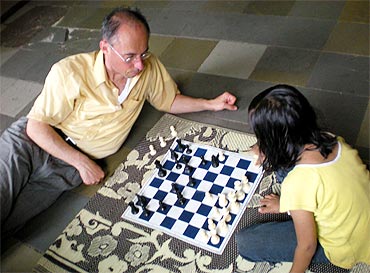 Dr James Levine, who works at Mayo Clinic in Minnesota, spends much of his time trying to find solutions to what he terms "people's ill-health" and on understanding NEAT.
Dr James Levine, who works at Mayo Clinic in Minnesota, spends much of his time trying to find solutions to what he terms "people's ill-health" and on understanding NEAT.
NEAT stands for non-exercise activity thermogenesis, very vital calories burnt outside of a daily exercise regime and consumed in the process of daily living.
NEAT calories burnt while walking back and forth while on the phone, climbing stairs, energy spent doing daily chores or merely fidgeting (remember those folks who shake the airport plastic chairs) are more important to keeping a person healthy because it reflects your daily habits. Levine's popular book Move a Little, Lose a Lot looks at how the absolute conveniences of modern life have robbed human beings of the 1,500-2,500 odd calories they once lost daily via NEAT.
But not many know that the professor of medicine -- who originally hails from Britain and has invented a walking desk to promote exercise on the job -- has also written a novel based in India. Titled The Blue Notebook, it is the story of a child prostitute named Batuk, from Mumbai, who records the miseries of her life in a little blue notebook.
Batuk is based on a young girl Levine observed on a trip to India. He recalls in an e-mail interview to Vaihayasi Pande Daniel that trip and what led him to write a novel on India.
What inspired you to write The Blue Notebook?
In 2002, with a team from the Food and Agricultural Organization, we reported in the medical journal Science, the impact of child labor on education and malnutrition in children from the Ivory Coast. We subsequently expanded these studies to Jamaica, China and several years later, India.
After an invitation from an Indian governmental agency, I arrived in New Delhi at 3 am where I was promptly kidnapped. Although I was incarcerated for only a few days, my response to this assault was far from robust. I was released by the police, numbed.
The day after being freed, I was flown to Mumbai to join the team I was to work with. There, touring several of the poorest urban areas with local agencies, I walked down the famed Street of Cages. This is one of the central areas for the estimated half-million child prostitutes in India.
Before leaving the Street of Cages, I saw a 15-year-old girl leaning against her bright blue steel gate. She wore a pink sari with a rainbow trim; she was writing in a blue notebook.
Having worked in numerous underserved areas, the mantra, 'education is the answer', is invariably touted as pivotal solution. That being so, I could not reconcile the image of a child prostitute who wrote. The girl in the pink sari, with the rainbow trim, haunted me to write The Blue Notebook, which is a work of fiction based upon fieldworkers' reports and observation of the conditions in which such children survive. I named the girl, Batuk. The book is about how Batuk rises above catastrophic personal circumstance.
Whenever I struggle amidst the simple luxuriant pressures of modern living, I think of Batuk and crave a droplet of her power to ascend.
Why was your team taken to the Cages (Mumbai's red light area)?
We were trying to understand the number of calories that children need to grow and learn optimally. Good nutrition leads to good health and better outcomes.
Till your visit to Mumbai's Cages did you have much knowledge of Indian prostitution or the way prostitution works in other parts of the world?
I had no idea how broad and important an international issue this is. There are one million child slaves in the world we need to set them free. Without Batuk I would have been blind like so many other people.
Why were you so taken with the young girl on whom Batuk's character is based?
I simply could not comes to terms with it. I saw her with a combination of awe and utter guilt that I was helpless in her aid. I still feel a sense of hopeless fallibility. Batuk, to me, was the human representation of strength and power.
Can you describe this Mumbai red light area from your perspective?
They are the cages of human enslavement. By having people children even exploited in such a devastating fashion, we lower ourselves as a human race.
Have you subsequently done a fair amount of background research in Indian prostitution?
Actually prior to The Blue Notebook being published I took a trip back to research the area and the issue in detail. I have interviewed with field workers children and adults so enslaved, madams and even some of the people involved in the business. I visited too, the tent where babies are rented by the day to increase beggar returns.
The scene at the cages horrified you. How do you plan to give back?
All US royalties [of The Blue Notebook] are donated to the International Center of Missing and Exploited Children (ICMEC.org). Half of remaining royalties go to local programs whose mission is to end childhood prostitution. Money though is not important I have dedicated my time, my heart and soul to free these children.
I have written seven times to the prime minister of India [requesting him] to meet with me. We are working through the International Center of Missing and Exploited Children to bring the message to the floor of the United Nations. We need to outlaw childhood prostitution and then enforce the ban immediately. We need to work in the field to find the scalable solutions to pull these children out, relocate them and rehabilitate them. They are the future. They are our children.
What response has The Blue Notebook received so far?
This book is a testament to the power of fiction to the power of story-telling. This work of fiction has touched tens of thousands of lives. If ever an example of how fiction meets social response I suppose this would be one. I have had people after reading The Blue Notebook: call me because they are adopting child prostitutes from India, I have met students going to India to work in the field, I was in Australia for the book's precipitation of a national campaign for child protection, I am meeting senators and senior politicians to bring the UN bill to reality, I am working with foundations, corporate sponsors and philanthropists to bring real-world solutions for these children to certainty. All this within four months of publication. The Blue Notebook Batuk's call will end the prostitution of the child.
Had you been to India before?
That was my first trip I have been back five times since. I love being in India. I plan to return in January. I am in love with India and Mumbai in particular. I think it simply one of the most beautiful and invigorating places on earth. I would live there (part time!) given the opportunity. The Indian people are simply the finest of the finest on the planet. If they were aware of what occurs in their name that detailed in The Blue Notebook childhood prostitution would end in India I am sure. The book, I hope, brings this message into the collective consciousness of one the earth's most beautiful nations. I hope it terminates the sexual exploitation of children in India.
Do you know what happened to the girl with the blue book? Did you ever feel the urge to trace her?
I went back to Mumbai to find her. She had disappeared. I would like to think that somehow she escaped, but the statistics argue against this. Batuk most likely was trafficked, moved or succumbed. I believe it extraordinary that her voice calls out literally across the world to us to act.






 © 2025
© 2025